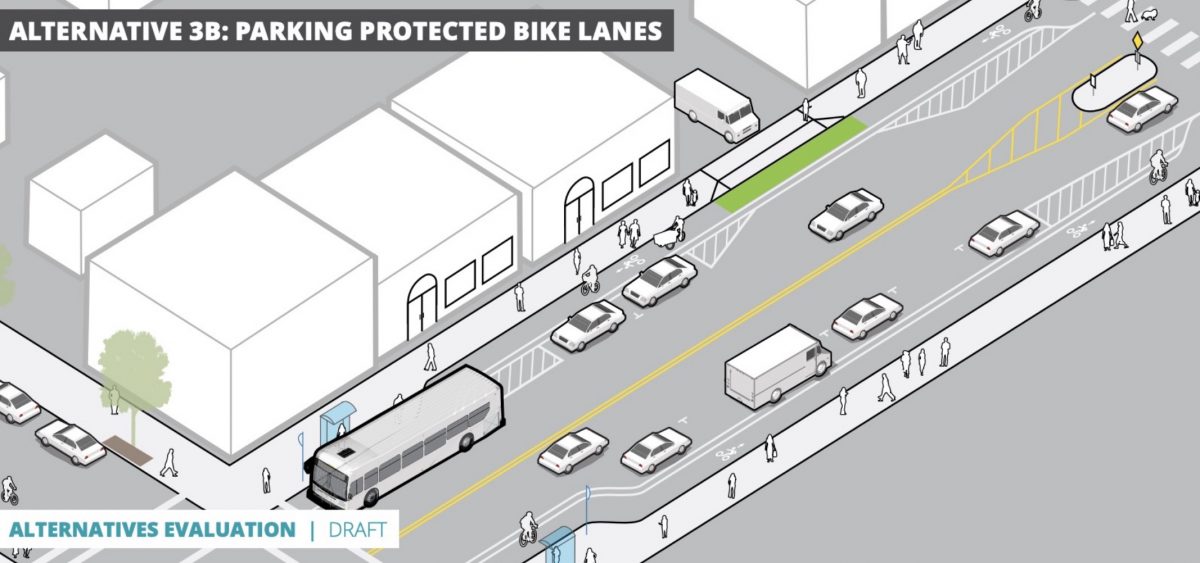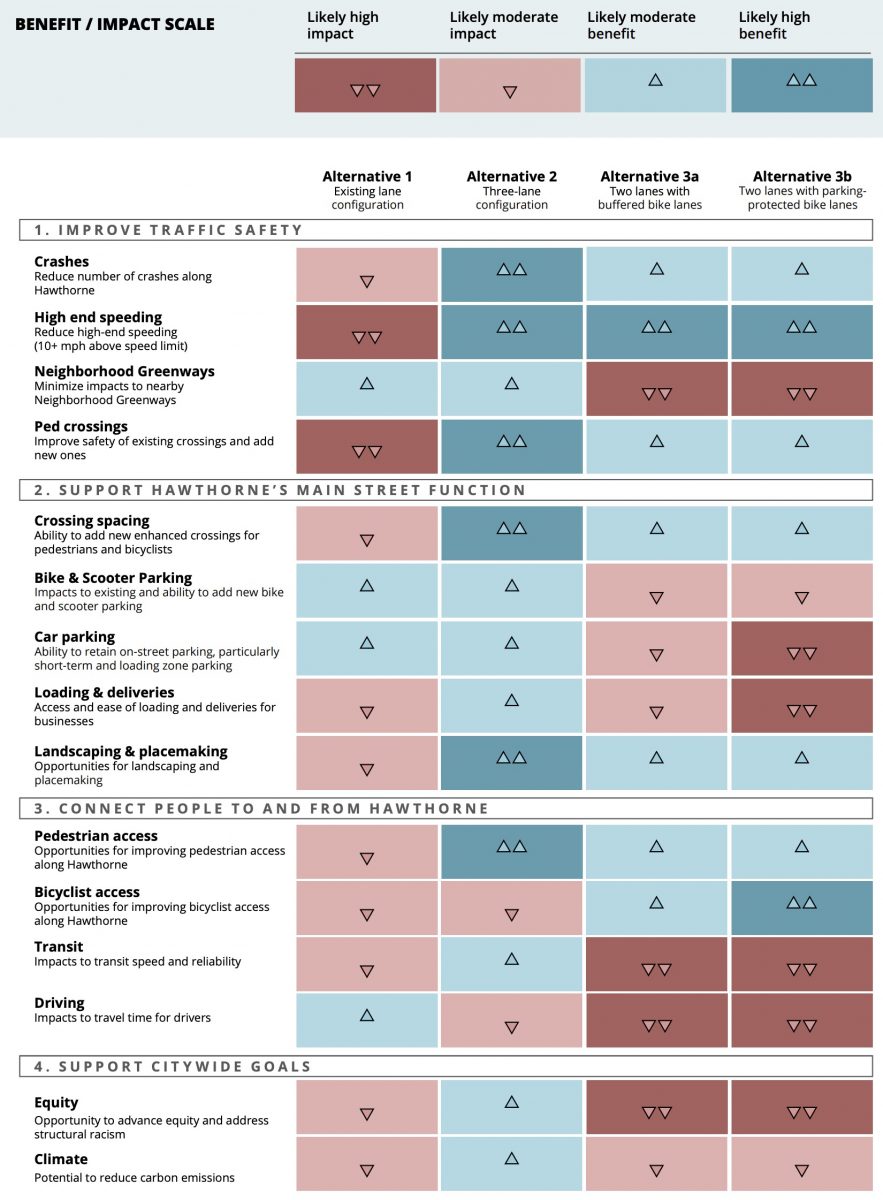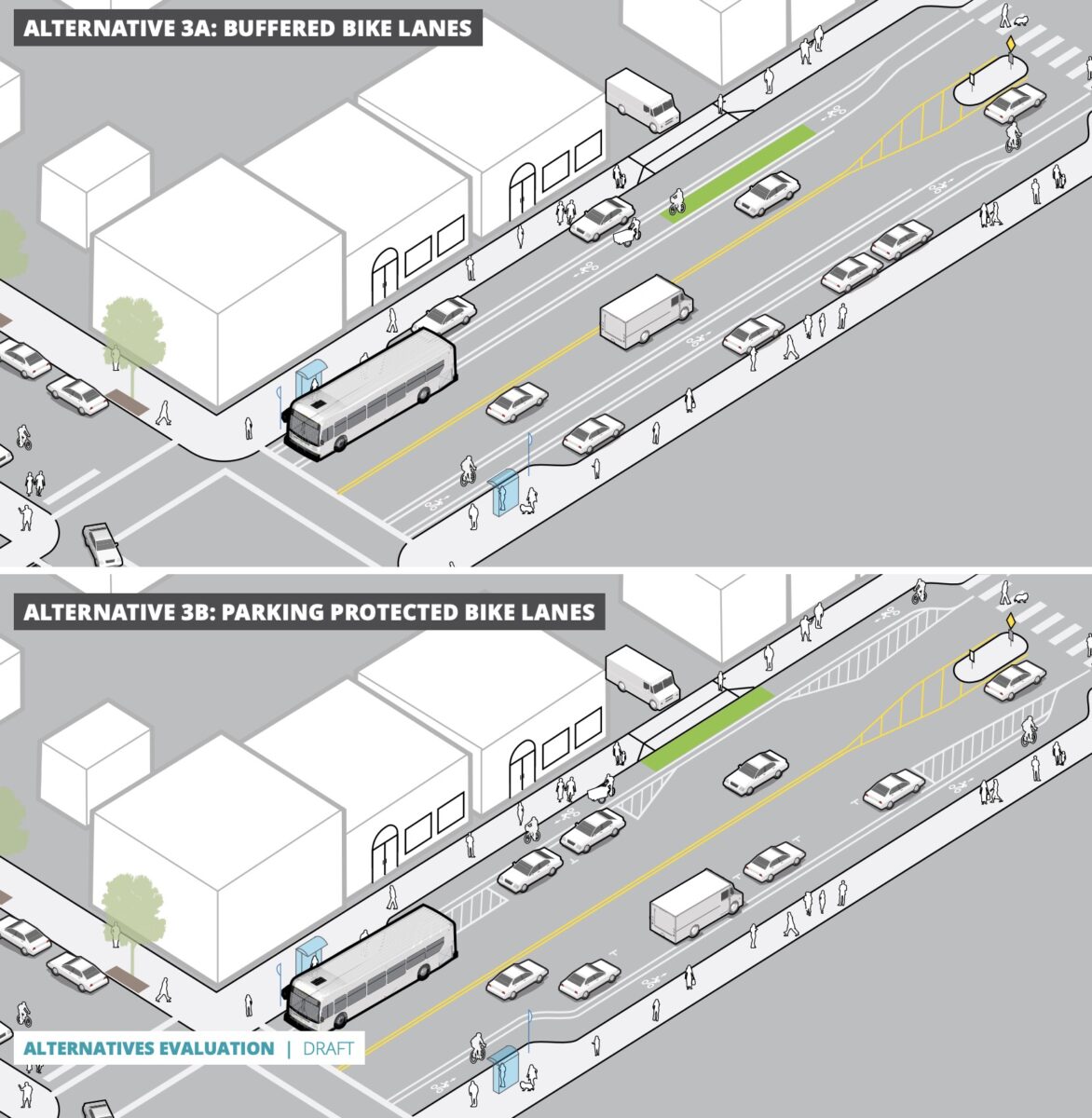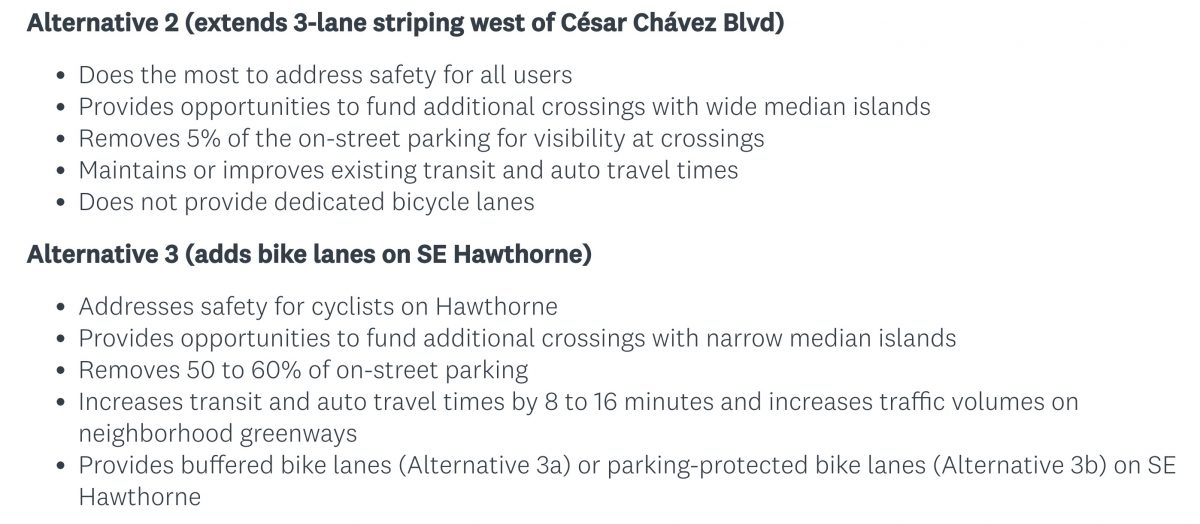
“…It is likely that the bike lanes would offer a mostly localized benefit to access destinations on the corridor rather than benefiting people further away in the Foster and Lents areas.”
— PBOT
A golden opportunity to create safe space on Hawthorne Boulevard for bicycle users might be slipping away. That’s the feeling of many local advocates following the release of a draft report yesterday by the Portland Bureau of Transportation on the SE Hawthorne Pave and Paint project.
Since we shared news of this project back in January there’s been a hope that bike lanes could finally be coming to one of Portland’s marquee main streets. There’s strong grassroots support for dedicated cycling space and back in May nearly 60 business owners said they’d support bike lanes.
Since Hawthorne is slated to be repaved from 24th to 50th, PBOT has a clean slate to replace the existing lane striping with something new. Currently this section of Hawthorne west of Cesar E Chavez Blvd (39th) has six lanes — four general traffic lanes and two lanes used to park cars. East of Cesar E Chavez Blvd, the road has five lanes — two for general traffic, one center turn lane, and two car parking lanes.
Here are the three options PBOT has under consideration:
- Alternative 1: Keep everything the same.
- Alternative 2: Extend the cross-section that currently exists east of Cesar E Chavez west to 22nd Avenue.
- Alternative 3a: Swap a general traffic lane for a buffered bike lane and maintain some of the on-street car parking.
- Alternative 3b: Swap a general traffic lane for a curbside, parking-protected bike lane and maintain some of the on-street car parking.


Advertisement
PBOT evaluates these three options based on five criteria: “Improve safety; Support Hawthorne’s Main Street function and help people get to destinations there; Connect people to other parts of the city; Will it advance equity and address structural racism? Will it reduce carbon emissions?”
As you can see below, PBOT has positioned option 2 as the clear winner:

Yes it appears PBOT is leaning toward no space for bicycle riders on Hawthorne. This is despite strong support for bike lanes and a 2030 Bike Plan that explicitly calls for them. Not surprisingly, this has set off a few alarm bells. “I hate the lack of ambition here,” tweeted transportation reformer and member of the PBOT Bicycle Advisory Committee Iain Mackenzie. “I think the whole thing is a joke and they will use this data to say why the status quo will continue,” activist and software developer Lance Poehler shared with me via email this morning.
To better understand PBOT’s justification, here’s how they summarize options 2 and 3:
Notably, the bike lane options got dinged for their expected negative impacts on nearby neighborhood greenways, “[auto] parking retention”, climate change and equity.
PBOT believes bike lanes on Hawthorne would force more drivers onto popular neighborhood greenways streets such as Salmon, Ladd, Harrison and Lincoln. PBOT’s analysis shows that the resulting number of drivers that would divert onto these streets would push them above the 2,000 cars per day maximum they allow on “low-stress, family-friendly” side streets.
Advertisement

Missing from this evaluation is any expectation that — if we succeed in updating our infrastructure in a way that makes driving less convenient — people might actually change behaviors and drive less.
And in another troubling sign for a city ostensibly committed to fighting climate change and boosting cycling and other non-driving trips, PBOT frames on-street auto parking as a necessity and a right, rather than a privilege. All three options maintain space for parking cars. Alternative 3b would lead to 225 fewer car parking spaces that PBOT says would, “Make it more difficult for people visiting the Hawthorne Business District to find parking,” and “be a significant impact to some main street businesses that rely on short-term vehicle access.”
Keep in mind as we discuss these options that if you use a car, walk or take transit, you are guaranteed some type of dedicated and safe space for that activity. However, if you use a bicycle, only Alternative 3 gives you this type of space. Put another way, for bicycle riders, we’re talking about whether or not there is access. For everyone else, we’re talking about how much access.
PBOT also tries to make the case that bicycle and car users sharing the same lane “would provide some safety improvement for cyclists that choose to take the lane,” because there would be “slower vehicle speeds and wider travel lanes”. They offer no citation for this claim.
The impact on transit times is framed by PBOT as the most serious threat posed by the addition of bike lanes. They say if bike lanes are added, Line 14 bus riders could expect between 8 and 16 minutes of delay. They also say reliability would suffer because drivers would back up behind bus drivers waiting for a gap in traffic to make turns. “Since Hawthorne Blvd is classified as a Major Transit Priority Street,” the report states, “this kind of travel time increase and reliability impact for the Line 14 would be very concerning.”
It’s important to keep in mind that PBOT is currently led by Commissioner Chloe Eudaly. The direct line between transit and racial equity in this report is very similar to Eudaly’s approach to transit in her Rose Lane Project. Suffice it to say, no design concept will survive if it delays transit by 8 to 16 minutes.
“…adding one stretch of bike lane in an area of Portland with among the highest bicycle mode shares in the city is likely to have less marginal benefit than improving one of the most frequent and highest-ridership bus lines in the area.”
— PBOT
For similar reasons, PBOT says bike lanes on Hawthorne would have a “high impact” on driving times and that the, “level of diversion onto lower classified streets would be concerning since it does not align with City policy.”
The report includes no analysis of how a lack of safe space on Hawthorne for bicycle riders negatively impacts cycling trip times.
The justification for giving bike lanes low marks on equity and reducing carbon emissions is also related to these claimed impacts on transit times.
Using their new focus on racial equity, PBOT says the bike lanes’ negative impact on transit speed and reliability would hurt low-income people who live in east Portland areas served by the Line 14 bus. PBOT acknowledges the benefit bike lanes would have for some, but they frame them it a “mostly localized benefit… rather than benefiting people further away in the Foster and Lents areas.” “Therefore, our conclusion is that Alternative 2 [which they say offers the most benefit to transit service] is more consistent with the goal of advancing equity and addressing structural racism with this project.”
For climate change impacts, PBOT said they leaned on Metro’s Climate Smart Strategy, which evaluated relative climate benefits of different transportation strategies. In that report, “make biking and walking safe and convenient” received 3 out of 5 stars, while “make transit convenient, frequent, accessible, and affordable” nabbed 5 out of 5 stars. “This seems especially true in this situation,” the report states, “since adding one stretch of bike lane in an area of Portland with among the highest bicycle mode shares in the city is likely to have less marginal benefit than improving one of the most frequent and highest-ridership bus lines in the area.” PBOT also says that the increased bus travel times would cancel out any climate benefits of new bike lanes.
Now that the report is out, it’s time to share your feedback. PBOT has released an online survey and will host two webinars to hear your input on these alternatives. Learn more on the project website.
— Jonathan Maus: (503) 706-8804, @jonathan_maus on Twitter and jonathan@bikeportland.org
— Get our headlines delivered to your inbox.
— Support this independent community media outlet with a one-time contribution or monthly subscription.





